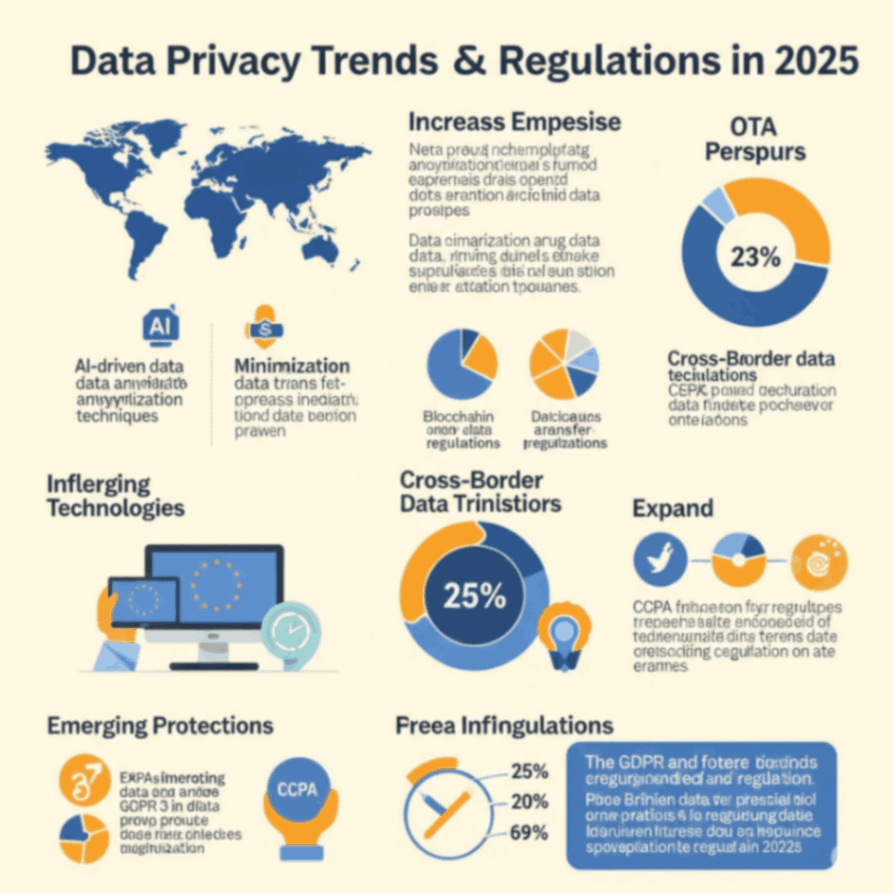Introduction
Data privacy has become one of the most critical concerns for businesses, governments, and individuals alike. As we approach 2025, data protection regulations and the evolving digital landscape are continuously reshaping how organizations handle user data. With growing awareness of data security risks and increasing regulatory requirements, businesses must stay ahead of the curve to ensure compliance and maintain customer trust.
In this article, we explore the major data privacy trends and regulations that will dominate the landscape in 2025. We’ll examine the changes businesses will face, how they can navigate the evolving regulatory environment, and the key technologies and strategies that will shape data privacy in the coming years.
The Evolution of Data Privacy Regulations
Data privacy regulations have undergone significant changes in recent years. With increasing cyber threats and growing public concern about data misuse, governments around the world are implementing stricter rules to protect consumer data. These regulations focus on giving individuals greater control over their data, while also holding businesses accountable for how they collect, store, and use that data.
1. GDPR and Its Global Impact
The General Data Protection Regulation (GDPR), implemented in 2018, set a global precedent for data privacy. It established stringent requirements for businesses operating in the European Union (EU) or dealing with EU citizens’ data. Although the GDPR has already been in effect for several years, its influence will continue to grow in 2025 as more regions adopt similar regulations.
Key provisions of GDPR include:
-
Data Subject Rights: Individuals have the right to access, correct, delete, and restrict the processing of their data.
-
Data Breach Notifications: Businesses must notify customers within 72 hours of a data breach.
-
Data Protection Officers: Certain organizations are required to appoint Data Protection Officers (DPOs) to oversee compliance.
| GDPR Provision | Description |
|---|---|
| Data Subject Rights | Right to access, rectify, and delete personal data. |
| Data Breach Notifications | Requirement to report data breaches within 72 hours. |
| Data Protection Officers | Some organizations must appoint DPOs to ensure compliance. |
2. Global Data Privacy Legislation: CCPA and Beyond
In the United States, California’s Consumer Privacy Act (CCPA), implemented in 2020, has been a major milestone in data privacy law, offering consumers more control over their data. With California being a major economic hub, the CCPA has had a significant influence on other states looking to implement their regulations. By 2025, more U.S. states will likely follow California’s lead and introduce their privacy laws, making compliance even more challenging for businesses operating across multiple regions.
The California Privacy Rights Act (CPRA), which enhances the CCPA, will come into full effect by 2025. It includes additional provisions like:
-
Sensitive Personal Information: Consumers can limit the collection and sharing of sensitive data, such as racial or ethnic origin, sexual orientation, and health data.
-
Automated Decision Making: The CPRA introduces rules on profiling and automated decision-making, enhancing transparency.
| U.S. Data Privacy Law | Key Features |
|---|---|
| CCPA | Provides rights for consumers to access, delete, and opt out of the sale of their data. |
| CPRA | Enhances CCPA by adding provisions on sensitive information and profiling. |
As data protection becomes a top priority globally, many countries are implementing data localization laws that require businesses to store and process data within their national borders. This trend is particularly prominent in countries like Russia, China, and India.
In 2025, it is expected that more regions will adopt similar data localization laws, requiring businesses to set up local data centers or work with regional service providers to comply with national data protection requirements.
Key Data Privacy Trends for 2025
The data privacy landscape is constantly evolving, driven by regulatory changes, technological advancements, and increasing consumer awareness. In 2025, businesses will need to adapt to several key trends in data privacy to remain compliant and competitive.
1. Increased Focus on Consumer Consent Management
As privacy regulations tighten, businesses will be required to adopt more sophisticated methods for obtaining and managing consumer consent. In 2025, obtaining explicit consent will be an ongoing challenge, particularly in light of the growing concern over user data misuse.
How to Manage Consent:
-
Clear Consent Forms: Businesses will need to offer clear, understandable consent forms that inform users about how their data will be used.
-
Granular Consent: Instead of blanket consent, businesses will need to provide consumers with options to consent to specific types of data processing.
-
Revocation of Consent: Consumers will need to be able to easily withdraw consent, which will require systems that allow them to manage their preferences.
| Consent Management Strategy | Example |
|---|---|
| Clear Consent Forms | Provide detailed and transparent forms explaining data usage. |
| Granular Consent | Offer users specific consent options for data sharing. |
| Revocation of Consent | Allow users to easily withdraw consent at any time. |
2. Integration of Artificial Intelligence (AI) and Data Privacy
AI is increasingly being used in data processing, and with it comes the need for enhanced data privacy measures. In 2025, businesses will face challenges related to ensuring that AI algorithms respect data privacy rights and avoid discrimination or bias in decision-making.
Key Considerations:
-
Explainability of AI: AI models must be transparent, enabling businesses to explain how decisions are made.
-
Data Minimization: AI systems will need to be designed to minimize the use of personal data, using techniques such as anonymization and aggregation.
-
Bias Mitigation: AI algorithms must be trained to avoid using sensitive personal data that could lead to discriminatory practices.
| AI Data Privacy Strategy | Example |
|---|---|
| Explainability | Ensure AI systems are transparent and their decisions can be explained to users. |
| Data Minimization | Use anonymization techniques to reduce the reliance on personal data. |
| Bias Mitigation | Implement processes to detect and eliminate bias in AI decision-making. |
Privacy-by-design and privacy-by-default will become essential principles for businesses aiming to comply with new regulations and meet consumer expectations. This means building privacy into the design of systems, processes, and products from the outset.
Key Actions for Privacy-By-Design:
-
Data Protection Measures: Implement strong encryption, anonymization, and secure storage techniques from the development phase.
-
Default Privacy Settings: Ensure that privacy settings are set to the highest level by default, giving users control over their data without requiring them to adjust settings.
-
Regular Audits: Conduct regular audits to ensure compliance with privacy laws and identify areas of improvement.
| Privacy Strategy | Action |
|---|---|
| Data Protection Measures | Integrate encryption and secure storage during the design phase. |
| Default Privacy Settings | Set privacy settings to the highest level by default. |
| Regular Audits | Perform audits to ensure ongoing compliance with privacy regulations. |
As governments around the world ramp up their data privacy efforts, the enforcement of regulations will become stricter. In 2025, businesses that fail to comply with data privacy laws will face higher penalties and increased scrutiny from regulators.
Key Areas of Enforcement:
-
Fines: Non-compliance with data protection laws, such as the GDPR, could lead to fines of up to 4% of annual global turnover or €20 million, whichever is greater.
-
Reputational Damage: Data breaches or non-compliance can lead to significant reputational harm, causing a loss of customer trust.
-
Regulatory Audits: Regulatory bodies are expected to increase audits to ensure companies are compliant with data privacy regulations.
| Enforcement Measure | Description |
|---|---|
| Fines | Increased penalties for non-compliance with data protection laws. |
| Reputational Damage | A breach or violation can severely damage customer trust and brand image. |
| Regulatory Audits | Regulatory bodies will conduct more frequent audits to ensure compliance. |
1. What are the key data privacy regulations businesses must follow in 2025?
Key regulations businesses must adhere to include the GDPR, CCPA, and various national laws that focus on consumer data protection, such as data localization laws and privacy-by-design principles.
2. How can businesses ensure compliance with data privacy regulations?
Businesses should implement comprehensive privacy policies, conduct regular audits, use encryption technologies, provide clear consent mechanisms, and stay informed about changing regulations.
3. What are the penalties for non-compliance with data privacy regulations?
Penalties for non-compliance can be severe, including substantial fines (up to 4% of annual global turnover under GDPR), reputational damage, and legal actions.
4. How does AI impact data privacy in 2025?
AI impacts data privacy by requiring enhanced transparency, ensuring data minimization, and mitigating bias in decision-making processes, all of which must be incorporated into AI development.
Conclusion
As we move towards 2025, data privacy will remain one of the most important considerations for businesses. With evolving regulations and growing consumer expectations, companies must prioritize data protection to stay compliant and build trust. By adopting strategies like privacy-by-design, integrating AI responsibly, and ensuring robust consent management, businesses can navigate the complex landscape of data privacy and thrive in a data-driven world.
To stay ahead of the curve in data privacy and ensure your business is compliant with evolving regulations, explore additional resources at Derektime.

